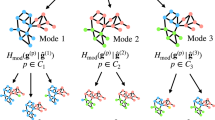Abstract
This paper discusses some of the issues raised by various approaches to decomposing functions and modular networks, and it offers a unified framework for multiple classifier (MC) systems in general. It argues that as yet there is no general approach to this problem although several approaches provide solutions to situations in which parametric labelling of a function allows the task facing classifying networks to be simplified. An MC connectionist system consisting of networks that process sub-spaces within a function based upon the similarity of patterns within its input domain is proposed and evaluated in the context of previous approaches to modular networks, and in the broader context of MC systems more generally. This simple automatic partitioning scheme is investigated using several different problems, and is shown to be effective. The degree to which the sub-spaces are specialized on a predictable subset of the overall function is assessed, and their performance is compared with equivalent single-network, and undivided multiversion systems. Statistical measures of ‘diversity’ previously used to assess voting MC systems are shown to apply to the measurement of the the degree of specialization or bias within groups of sub-space nets as well as provide a useful indicator across the range of MC systems. By successively increasing the overlap between sub-space partitions we show a transition from experts subnets, through voting version sets to optimal single classifiers. Finally, a unified framework for MC systems is presented.
Access this chapter
Tax calculation will be finalised at checkout
Purchases are for personal use only
Preview
Unable to display preview. Download preview PDF.
Similar content being viewed by others
References
Bauer, E. and Kohavi, R., 1998, An empirical comparison of voting classification algorithms: bagging, boosting, and variants, Machine Learning, vol. 13, pp. 1–38.
Bishop, C.M. 1995, Neural Networks for Pattern Recognition, Oxford University Press, Oxford.
Drucker, H., Schapire, R. and Simard, P., 1993, Improving performance in neural networks using a boosting algorithm, Advances in Neural Information Processing Systems 5, 42–49.
Drucker, H. et.al., 1994, Boosting and other ensemble methods, Neural Computation vol. 6, no. 6, pp. 1289–1301.
Frey, P. and Slate, D., 1991, Letter recognition using holland-style adaptive classifiers. Machine Learning, vol. 6, pp. 161–182.
Geman, S., Bienenstock, E. and Doursat, R. 1992, Neural networks and the bias/variance dilemma. Neural Computation, vol. 4, no. 1, pp. 1–58.
Jacobs, R. A., Jordan, M. I, Barto, A. G., 1991, Task decomposition through competition in a modular connectionist architecture: the what and where vision tasks, Cognitive Science, vol. 15, pp. 219–250.
Jacobs, R. A., Jordan, M. I., Nowlan, S.J. & Hinton, G.E., 1991, Adaptive Mixtures of Local experts, Neural Computation, vol. 3, pp. 79–87.
Jacobs, R. A., and Jordan, M. I., 1991, A Competitive Modular Connectionist Architecture, Advances in Neural Information Processing Systems 3, R. P. Lippman, J. Moody and D. S. Touretzky (Eds.), 767–773.
Jacobs, R. A., 1997, Bias/Variance analyses of mixtures-of-experts architectures Neural Computation, vol. 9, pp. 369–383.
Jordan, M. I., and Jacobs, R.A., 1994, Hierarchical Mixtures of experts and the EM Algorithm, Neural Computation, vol. 6, pp. 181–214.
Kohonen, T., 1989, Self-organization and Associative Memory, Springer Verlag, Berlin.
Littlewood, B., and Miller, D. R., Conceptual modelling of coincident failures in multiversion software engineering, 1986, IEEE Trans. on Software Engineering, vol. 15, no. 12, pp. 1596–1614.
Nowlan, S. J., and Hinton, G. E., 1991, Evaluation of Adaptive Mixtures of Competing Experts, Advances in Neural Information Processing Systems 3, R. P. Lippman, J. Moody and D. S. Touretzky (Eds.), 774–780.
Partridge, D., 1996, Network Generalization Differences Quantified, Neural Networks, vol. 9, no. 2, pp. 263–271.
Partridge, D., and Griffith, N., 1995, Strategies for Improving Neural Net Generalisation, Neural Computing & Applications, vol. 3, pp. 27–37.
Partridge, D., and Krzanowski, W., 1997, Software Diversity: practical statistics for its measurement and exploitation, Information and Software Technology, vol. 39, pp. 707–717.
Partridge, D., and Yates, W. B., 1996, Engineering Multiversion Neural-Net Systems, Neural Computation, vol. 8, no. 4, pp. 869–893.
Partridge, D. and Yates, W. B., 1997, Data-defined Problems and Multiversion Neural-net Systems, Journal of Intelligent Systems, vol. 7, nos. 1–2, pp. 19–32.
Perrone, M. (Ed), 1993, Pulling it all together: methods for combining neural networks, ONR Tech. Rep. 69, Institute for Brain and Neural Systems, Brown University (http://www.mpp@brown.edu).
Rumelhart, D.E and Hinton, G.E. and Williams, R.J., 1986, Learning internal representations by error propagation., In Parallel Distributed Processing: Explorations in the Micro structure of Cognition, Vol. 1:Foundations, (Eds.) D.E Rumelhart and J.L. McClelland, MIT Press, Cambridge, MA:.
Schapire, R., 1990, The strength of weak learnability. Machine Learning, vol. 5, no. 2, pp. 197–227.
Author information
Authors and Affiliations
Rights and permissions
Copyright information
© 2000 Springer-Verlag Berlin Heidelberg
About this paper
Cite this paper
Griffith, N., Partridge, D. (2000). Self-Organizing Decomposition of Functions. In: Multiple Classifier Systems. MCS 2000. Lecture Notes in Computer Science, vol 1857. Springer, Berlin, Heidelberg. https://doi.org/10.1007/3-540-45014-9_24
Download citation
DOI: https://doi.org/10.1007/3-540-45014-9_24
Published:
Publisher Name: Springer, Berlin, Heidelberg
Print ISBN: 978-3-540-67704-8
Online ISBN: 978-3-540-45014-6
eBook Packages: Springer Book Archive




